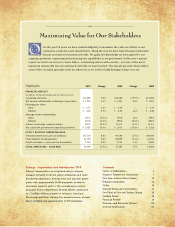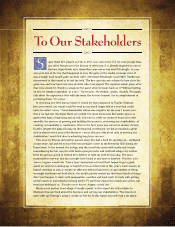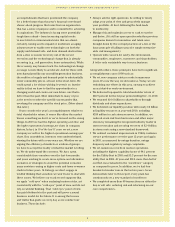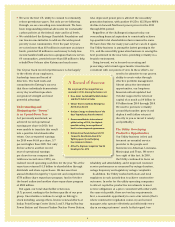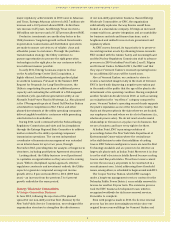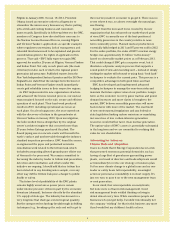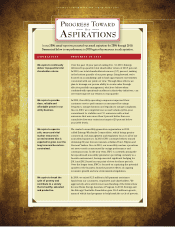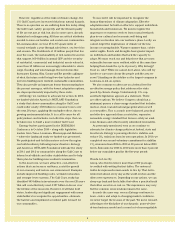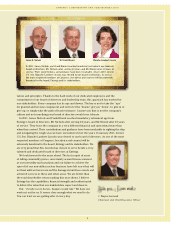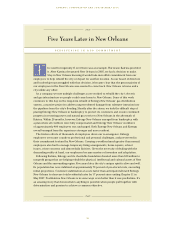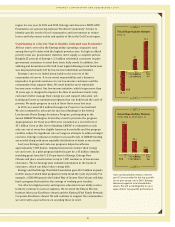Entergy 2010 Annual Report Download - page 8
Download and view the complete annual report
Please find page 8 of the 2010 Entergy annual report below. You can navigate through the pages in the report by either clicking on the pages listed below, or by using the keyword search tool below to find specific information within the annual report.
Pilgrim in January 2006. On Jan. 18, 2011, President
Obama issued an executive order to all agencies to
streamline the unnecessary bureaucracy that is putting
jobs at risk and costing business and consumers
unnecessarily. Specifi cally in follow-up letters to the NRC,
members of Congress have directed their concerns to
the Nuclear License Renewal Process, naming Pilgrim
and Vermont Yankee’s applications as specifi c examples
where regulatory uncertainty, lack of transparency and
extended timeframes need to be explained and greater
consideration given to the rights of applicants in this
process. That said – EWC fully expects to gain NRC
approval for another 20 years at Pilgrim, Vermont Yankee
and Indian Point. Not only is each plant safe (the main
criterion) but also each is vital to the regional power
generation infrastructure. Published reports from the
New York Independent System Operator and the ISO New
England have stated that the unexpected retirement of
Indian Point and Vermont Yankee would immediately
create grid reliability issues in their respective regions.
As EWC implemented its new organization structure
and advanced the license renewal process, our nuclear
team remained focused on the safe, secure and effi cient
operation of each plant. Their hard work produced
results in 2010, including operational successes at
each plant. On a less happy note, the year started out
with the discovery of tritium in the groundwater at
Vermont Yankee in January 2010. Upon investigation,
the leak resulted from a design fl aw by the original
owner’s architect/engineer that occurred more than
25 years before Entergy purchased the plant. The
fl awed piping was in concrete vaults well beneath the
earth’s surface and unobservable through the industry
standard inspection procedures. EWC found the source,
re-engineered the pipes and performed extensive
remediation work related to the tritium leak, which
included transporting affected groundwater offsite out
of Vermont to be processed. We remain committed to
becoming the industry leader in tritium leak prevention,
detection and remediation, and efforts under this
initiative are ongoing. I should add that no tritium has
been detected in any drinking water sample, or in any
other way did the tritium leak pose a danger to public
health or safety.
The future level of profi tability of the EWC plants
remains highly uncertain as power prices remain
under intense pressure; driven in part by the economic
downturn (demand), but more directly by the abundant
U.S. supply of shale gas. The industry has known for a
very long time that shale gas existed in great quantity.
But the unexpected technology breakthrough in drilling
techniques (e.g., breaking up the rock and soil to get to
the reserves) made it economic to go get it. There was no
secret where it was, so almost overnight the natural gas
was fl owing.
In part from the increased focus created by its new
organization that has enhanced our market-based point
of view, EWC is currently one of the best-positioned
non-utility generators in the country relative to near-
term commodity prices. Planned nuclear production is
essentially fully hedged in 2011 and 87 percent sold in 2012.
For the entire portfolio, the value of EWC’s nuclear energy
hedges was approximately $1 billion “in-the-money”
based on observable market prices as of February 2011.
That could change if EWC gets a surprise event, but it
illustrates a dynamic analysis process that supports a
sound point of view and executing on it – instead of simply
wishing the market will rebound or using basic “look back”
techniques to evaluate the current price. This process is a
competitive advantage in both good times and bad.
EWC has developed and implemented advanced
hedging techniques to manage the near-term risks and
maintain the future option value of our portfolio. Longer
term, as the economic recovery gains traction and power
demand increases and more clarity is brought to the
market, EWC believes non-utility generators will move
back in favor with more of the market. The enactment
of new environmental regulations and any federal or
state legislation limiting carbon emissions or mandating
increased use of less carbon-intensive generation
resources would further favor clean nuclear generation.
The option value of EWC’s assets is potentially substantial
in the long term and we are committed to realizing that
value for our shareholders.
Advocating for Action on
Climate Risks and Adaptation
I have no doubt that if Entergy Corporation faced a risk
that presented enormous potential downsides such as
having a large fl eet of greenhouse gas-emitting power
plants, our board of directors and leadership team would
act immediately to revise our strategy or business plan.
Yet because climate change is a global issue and no one
leader or entity bears full responsibility, meaningful
action or personal accountability is in short supply. It’s
just too easy to pass it on to the next management team
or next generation.
In our mind, that is irresponsible on many fronts,
but none more so than in risk management. Good
risk management beats wishful thinking or living in
denial almost every time. While sometimes people and
businesses do just get lucky, I wouldn’t intentionally bet
the company “wishing” for that in this business any more
than I would bet my children’s health or lives.
6



